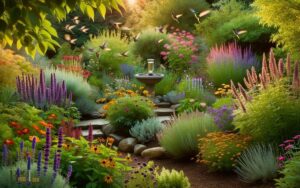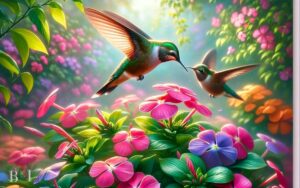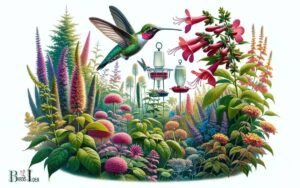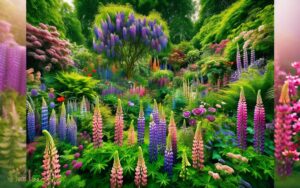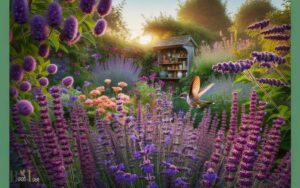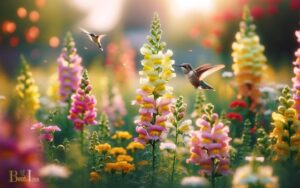Does Red Salvia Attract Hummingbirds? Yes!
Yes, red salvia, also known as scarlet sage, is known to attract hummingbirds. With its bright red, tubular flowers, it provides an excellent nectar source for these birds.
Red salvia (Salvia splendens) is a popular plant among gardeners who aim to attract hummingbirds.
The plant’s vibrant red blossoms are particularly appealing to hummingbirds for a few reasons:
Planting red salvia in your garden can create a hummingbird-friendly habitat, increasing the likelihood of these birds visiting and providing a delightful natural spectacle.
Incorporating red salvia into landscaping not only adds a splash of color but also supports local hummingbird populations by supplying a valuable food source.
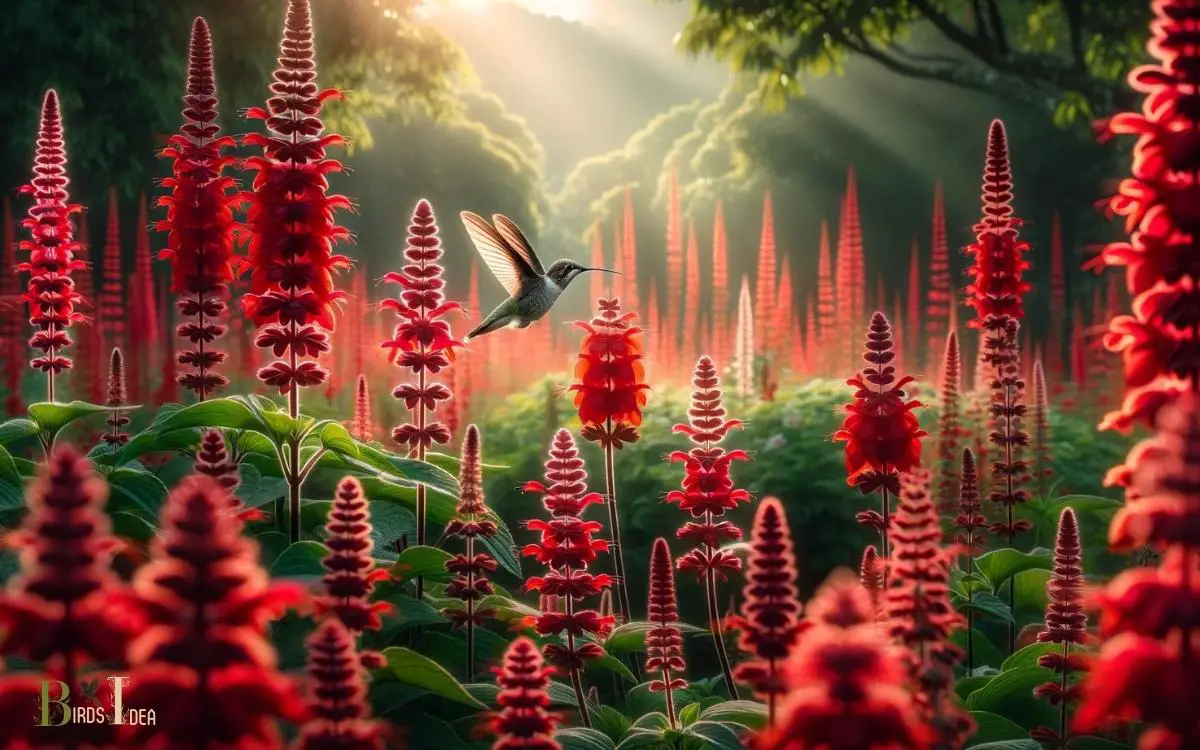
Key Takeaway
Red Salvia: A Hummingbird Favorite
Red Salvia Attracts Hummingbirds
Red salvia is a favorite among hummingbirds for several reasons:
- Bright red flowers: Hummingbirds are attracted to the color red, and red salvia’s vibrant flowers act as a natural beacon for these birds.
- Abundant nectar production: Red salvia produces ample nectar, providing a valuable food source for hummingbirds and encouraging their frequent visits.
- Long blooming period: Red salvia blooms for an extended period, ensuring a sustained food source for hummingbirds throughout the flowering season.
Benefits of Planting Salvia
Planting salvia in a garden can provide numerous benefits for attracting hummingbirds.
- Vibrant Blooms: Salvia produces bright red, tubular flowers that are particularly attractive to hummingbirds. The striking color and shape of the blooms act as a beacon for these delightful birds.
- Long Blooming Period: Salvia typically has an extended blooming period, providing a consistent nectar source for hummingbirds throughout the growing season.
- Low Maintenance: Salvia is relatively low maintenance once established, making it an easy addition to a garden. Its resilience and adaptability make it a great choice for both novice and experienced gardeners.
The Science of Hummingbird Attraction
Many factors contribute to hummingbird attraction, including the color and shape of flowers, the nectar’s sugar concentration, and the presence of perches.
Red salvia’s vibrant blooms and nectar-rich flower clusters make it particularly appealing to hummingbirds.
Additionally, by visiting these flowers, hummingbirds play a crucial role in pollination, benefiting both the plants and the birds themselves.
Nectar-Rich Flower Clusters
With their nectar-rich flower clusters, red salvia plants attract hummingbirds due to their vibrant color and high sugar content.
The science behind this lies in the following factors:
- Color Attraction: Hummingbirds are drawn to the bright red hue of the salvia flowers, as these birds have a strong affinity for vibrant colors.
- High Sugar Content: The nectar produced by red salvia is rich in sucrose, a type of sugar that provides a high-energy fuel source for hummingbirds.
- Abundance of Flowers: Red salvia plants often produce numerous flower clusters, providing an ample food source for hummingbirds and increasing the likelihood of attracting these beautiful birds to a garden or outdoor space.
Understanding the nectar-rich flower clusters of red salvia sheds light on the fascinating dynamics of hummingbird attraction.
Hummingbirds and Pollination
Hummingbird attraction hinges on the interplay between their foraging behavior and the pollination of nectar-rich flowers.
As hummingbirds feed on nectar, their heads come into contact with the reproductive parts of flowers, transferring pollen from one bloom to another. This process, known as pollination, is essential for the reproduction of flowering plants.
Hummingbirds have co-evolved with certain flowers, developing specialized beaks and tongues to access nectar deep within the blooms.
In return, they inadvertently pick up and transfer pollen, facilitating the plants’ reproduction. This mutually beneficial relationship has led to the coevolution of hummingbirds and nectar-producing flowers.
Understanding the intricate mechanisms of pollination and the role of hummingbirds in this process is crucial for appreciating their significance in maintaining diverse ecosystems.
Understanding Hummingbird Behavior
Observing hummingbirds in their natural habitat reveals their remarkable agility and territorial nature when foraging for nectar-rich flowers.
To understand hummingbird behavior, consider the following:
- Territorial Nature: Hummingbirds fiercely defend their feeding territories, often engaging in aerial chases to protect their food source.
- Feeding Patterns: These birds have high metabolic rates and must feed frequently, visiting hundreds of flowers each day to meet their energy needs.
- Courtship Displays: Male hummingbirds perform elaborate aerial displays to attract females, showcasing their vibrant plumage and agility.
Understanding these behaviors provides insight into the preferences and habits of hummingbirds, shedding light on the factors that influence their flower choices.
By comprehending their behavior, one can better cater to their needs and attract them to specific plants.
Factors That Influence Bird Preferences
A thorough understanding of the factors that influence hummingbird preferences is essential for creating an environment that attracts and sustains hummingbirds.
Several factors influence hummingbird preferences when it comes to selecting flowers and visiting specific areas.
Here are some key factors:
- Color: Hummingbirds are attracted to bright and vibrant colors, especially shades of red, orange, and pink. These colors are easily visible to them and signal a potential source of nectar.
- Shape and Size of Flowers: Hummingbirds prefer tubular-shaped flowers that accommodate their long bills and allow them to access nectar easily. Flowers with a convenient perch nearby can also be attractive.
- Nectar Production: Hummingbirds are energy-efficient foragers, and they prefer flowers that provide ample nectar. Plants that continuously produce nectar or have a high concentration of it are more likely to attract hummingbirds.
- Scent: While humans may not be able to detect the scent of many hummingbird-pollinated flowers, some studies suggest that hummingbirds may be attracted to certain floral scents. However, the role of scent in hummingbird plant selection is not as well-understood as it is in other pollinators.
- Location and Habitat: The availability of suitable perching spots and the overall habitat influence hummingbird preferences. They may frequent areas with a mix of open spaces and cover for nesting and resting.
- Seasonal Availability: Hummingbirds have a high metabolism and need a consistent supply of nectar. Plants that bloom throughout the seasons provide a more reliable food source for them.
Understanding these factors can help individuals and gardeners create hummingbird-friendly environments by planting suitable flowers, providing nesting materials, and ensuring a consistent source of water.
By considering these factors, it is possible to create a habitat that meets the preferences of hummingbirds and supports their survival and well-being.
Landscaping With Red Salvia for Hummingbirds
Red Salvia is an excellent choice for landscaping to attract and nourish hummingbirds. Planting red salvia strategically in a garden or yard can create a vibrant and inviting environment for these tiny, energetic birds.
By incorporating red salvia into landscaping, individuals can enjoy the benefits of attracting and supporting hummingbird populations in their outdoor spaces.
Landscaping Tips for Hummingbirds
One popular landscaping tip for attracting hummingbirds is to incorporate red salvia into the garden design.
Red salvia, with its vibrant red flowers, is known to attract hummingbirds due to its rich nectar content and tubular shape, which is well-suited for the long bills of hummingbirds.
When landscaping with red salvia for hummingbirds, it’s important to plant it in clusters or drifts to create a visually appealing and functional space for these tiny birds.
Additionally, incorporating other hummingbird-friendly plants such as trumpet vine, bee balm, and penstemon can further enhance the attractiveness of the garden.
Providing a variety of nectar-rich flowers that bloom at different times throughout the season can help sustain hummingbirds and encourage them to frequent the garden.
By creating a habitat that meets their needs, gardeners can enjoy the delightful presence of hummingbirds in their outdoor space.
Tips for Attracting Hummingbirds With Red Salvia
To attract hummingbirds with red salvia, gardeners should plant the flowers in a sunny location with well-drained soil. Red salvia is a favorite of hummingbirds due to its tubular flowers that are rich in nectar.
Here are some tips for attracting hummingbirds with red salvia:
| Tip | Description | Benefit |
|---|---|---|
| Plant in clusters | Planting red salvia in clusters makes it easier for hummingbirds to spot and visit the flowers. | Increases the visibility and accessibility of the flowers for hummingbirds. |
| Provide a water source | Having a birdbath or shallow water feature near the red salvia provides hummingbirds with a hydration source. | Helps attract and sustain hummingbirds in the garden. |
| Choose different varieties | Planting different varieties of red salvia ensures a continuous bloom period, providing a consistent food source for hummingbirds. | Extends the availability of nectar for hummingbirds throughout the growing season. |
Maintaining a Hummingbird-Friendly Garden
In maintaining a hummingbird-friendly garden, it is essential to consistently provide a variety of nectar-rich flowers throughout the growing season.
This ensures a continuous food source for the hummingbirds. Additionally, keeping the garden free from pesticides and herbicides is crucial as these chemicals can be harmful to the birds.
Creating a water source such as a birdbath or fountain can also attract hummingbirds, as they need to drink and bathe regularly.
Finally, maintaining a clean and well-maintained garden space is important for attracting and retaining hummingbirds, as they are more likely to frequent an area that provides a safe and welcoming environment.
By following these practices, one can create a garden that is not only beautiful but also serves as a haven for these delightful creatures.
- Provide a variety of nectar-rich flowers
- Avoid pesticides and herbicides
- Create a water source
Conclusion
Red salvia is a surefire way to attract hummingbirds to your garden. With its vibrant red blooms and nectar-filled flowers, it’s no wonder that these tiny birds are drawn to this plant.
Like a beacon in the garden, red salvia lights up the landscape and invites hummingbirds to dance among its petals.
So, if you want to enjoy the sight of these beautiful birds in your yard, consider adding some red salvia to your landscaping.

